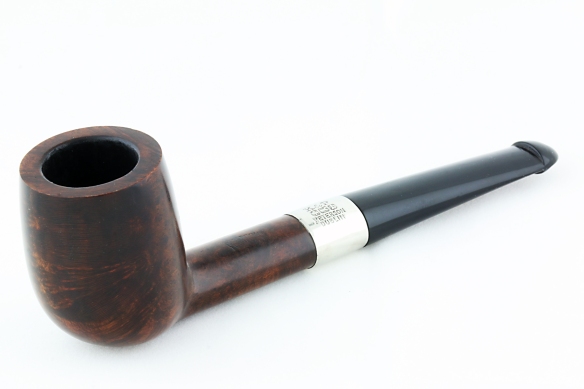108. The Old 900 Shape Group: Restoring an IFS 949 Oval-Shank Billiard
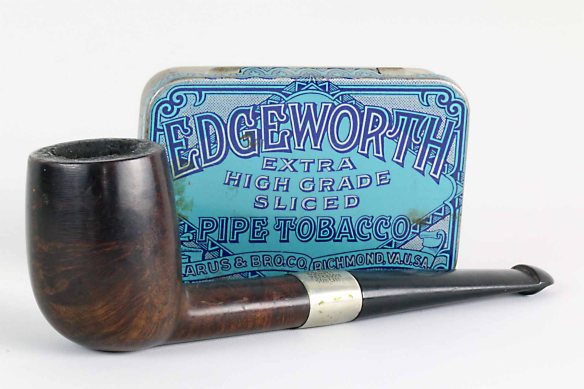 James Arrington, who entrusted me with his Late Patent-Era House pipe, also sent me a vintage billiard to restore that I think you’ll find interesting. It’s one of those shapes that deserve to be reintroduced to the catalog, for one thing—an oval-shank that can be set on a flat surface.
James Arrington, who entrusted me with his Late Patent-Era House pipe, also sent me a vintage billiard to restore that I think you’ll find interesting. It’s one of those shapes that deserve to be reintroduced to the catalog, for one thing—an oval-shank that can be set on a flat surface.
One of the great things that characterizes Peterson as a marque is its emphasis on practicality. Over the years the company has released a number of “setters” or flat-bottomed pipes, both bents and straights. There aren’t any oval-shanked straights in the current production catalog, although the classic dublin 120F (“F” in this case for flat) was in the catalog as late as 1965. And then there’s this amazingly dynamic, forward-canted oval-shank billiard.
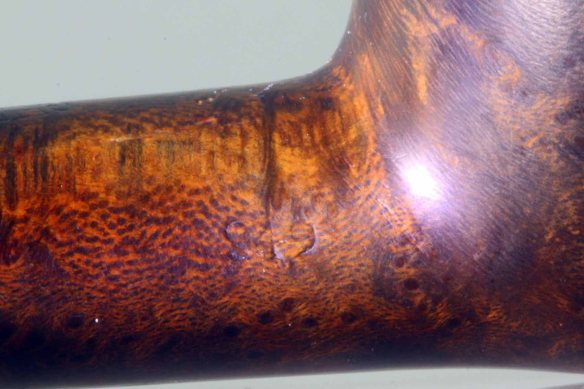

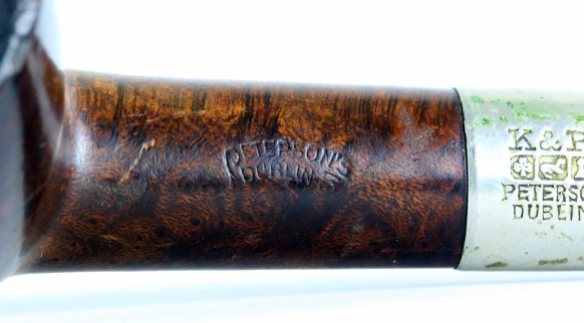 The pipe is stamped with number 949 on the reverse, IRISH over FREE STATE on the bottom of the shank at the mortise, and fork-tail “Peterson’s” over Dublin3 on the top of the shank. The 900-shape group is first glimpsed in a Viennese distributor’s Peterson chart from the mid-1920s and was firmly ensconced by the 1937 catalog, where it is presented in the “K” and “1st Quality” lines as the 949 and in the Kapet and De Luxe lines as the 260. The same shape (as sometimes happens with Peterson) is double-described.
The pipe is stamped with number 949 on the reverse, IRISH over FREE STATE on the bottom of the shank at the mortise, and fork-tail “Peterson’s” over Dublin3 on the top of the shank. The 900-shape group is first glimpsed in a Viennese distributor’s Peterson chart from the mid-1920s and was firmly ensconced by the 1937 catalog, where it is presented in the “K” and “1st Quality” lines as the 949 and in the Kapet and De Luxe lines as the 260. The same shape (as sometimes happens with Peterson) is double-described.
 Twenty-one shapes from the 900 group are found in the 1937 catalog, but by the 1945 catalog this numbering system had disappeared, with the shapes formerly double-described moving into the Classic Range numbers still in use today.
Twenty-one shapes from the 900 group are found in the 1937 catalog, but by the 1945 catalog this numbering system had disappeared, with the shapes formerly double-described moving into the Classic Range numbers still in use today.
The usefulness of this knowledge for the collector is in knowing that, with one or two exceptions, almost any pipe with a 900 number was made before 1945. (I’m not forgetting the 999 or its brief-lived cousin, the 998 that became the 999.) The big 1942 George Yale catalog illustrates sixteen of these shapes, and a close scrutiny of the page shows the shank on the large pipe is stamped SHAMROCK and the nickel band is stamped with a shamrock image under the nickel marks, both indicative of the Rogers Imports Shamrock line. (The page is reproduced on p. 102 of the book.)
James’s pipe is an earlier-made example of the large pipe, which seems to have been mis-marked as the slightly-smaller oval shank 977. The apple in the Yale page is part of the same problem: it is really shape 969 (per the 1937 catalog).
I love how these old catalogs would once in a while throw the pipeman a bone in the way of a 1 to 1 reproduction. George Yale did a good job sizing the image of the pipe—as you can see, they match up almost perfectly.
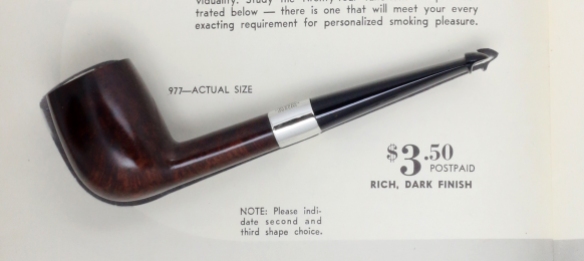 At present, Peterson make a series of billiards that could almost be matryoshka (nesting) dolls: you can start with the incredible 107 and nest inside it the incrementally smaller X105, 105 and 101. I wish they’d bring a little more diversity to their straight billiards and back the old diamond-shanked 109 and something like this oval-shank 949, or even the old 1049, a square-shank straight billiard.
At present, Peterson make a series of billiards that could almost be matryoshka (nesting) dolls: you can start with the incredible 107 and nest inside it the incrementally smaller X105, 105 and 101. I wish they’d bring a little more diversity to their straight billiards and back the old diamond-shanked 109 and something like this oval-shank 949, or even the old 1049, a square-shank straight billiard.
 The cake was simply amazing. Reaming actually brought the weight of the pipe down by 3.5 gr and cleared out a very clean and tidy chamber with the classic Peterson dimensions of 19.6mm x 40.00. It also made itself very aware to my nose that this pipe, so carefully and fastidiously smoked (notice it was never clenched between the teeth) was also never reamed. And it smelled it. So, in it went for a good long soak in the isopropyl bath—48 hrs. When it came out, the stain was lightened, as I expected, but nothing a very light wash of medium-brown won’t cure.
The cake was simply amazing. Reaming actually brought the weight of the pipe down by 3.5 gr and cleared out a very clean and tidy chamber with the classic Peterson dimensions of 19.6mm x 40.00. It also made itself very aware to my nose that this pipe, so carefully and fastidiously smoked (notice it was never clenched between the teeth) was also never reamed. And it smelled it. So, in it went for a good long soak in the isopropyl bath—48 hrs. When it came out, the stain was lightened, as I expected, but nothing a very light wash of medium-brown won’t cure.
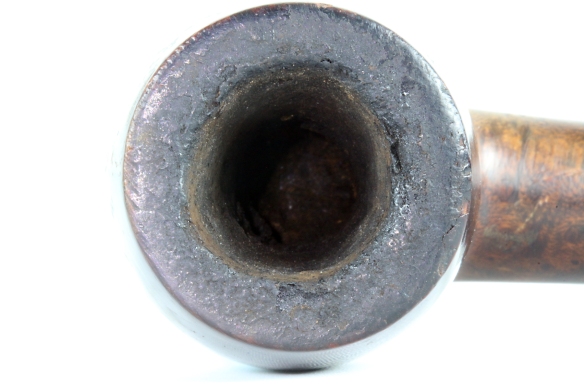 The bath also brought home the damage done to the rim’s outer and inner edges. This time I applied 100 grit first, from a standing position to give me more torque, and the work went very quickly through the 150, 220 and 400 grits.
The bath also brought home the damage done to the rim’s outer and inner edges. This time I applied 100 grit first, from a standing position to give me more torque, and the work went very quickly through the 150, 220 and 400 grits.
With the outer edge crisp, next came the decision of what to do with the inner rim. Underneath all that carbon, someone had been fairly cavalier with a knife, giving the chamber an out-of-round effect caused by gashes on two sides.
A Grade 3 would never have an inner bevel. Looking at the Peterson billiards in my rotation, only my Supreme has one, as a matter of fact. In the end, the desire to make the pipe look as fine as possible won, and I gave it as slight a bevel as possible, because the walls aren’t as thick as some Pete bowls. I used the 220 grit to “saw” the 45-degree angle into the chamber, then “wisped” 400 grit sideways around the inner rim to give the edge a uniform width.
There were a few “meteor showers” and “falling stars” on the bowl, which I took out with steam heat (heated flat-heat screwdriver pressed against wet t-shirting onto bowl). Then I sanded the bowl at 400, being careful to tape over all the bowl stamps first.
Some of the finish color was removed with the 400 and 600 grit, not surprising considering the pipe dates to at least 1937.
Afterwards I made a weak black-stain wash and coated the rim several times.
Old Peterson stamps can be weak and indistinct. This time, I gave all three stamp areas (949, IRISH FREE STATE and Peterson’s over Dublin 3) a few coats of the weak black-stain wash, to bring out the visibility of the stamps. This helped a little, but not as much as I’d hoped. I’d like to know from someone “more senior”: what I could do to make them stand out more?
 Then I made, then made the stain a little stronger and coated the entire bowl. As you can see in the photo, a black wash doesn’t stain the pipe black, but brings up the original black undercoating applied to bring out the grain.
Then I made, then made the stain a little stronger and coated the entire bowl. As you can see in the photo, a black wash doesn’t stain the pipe black, but brings up the original black undercoating applied to bring out the grain.
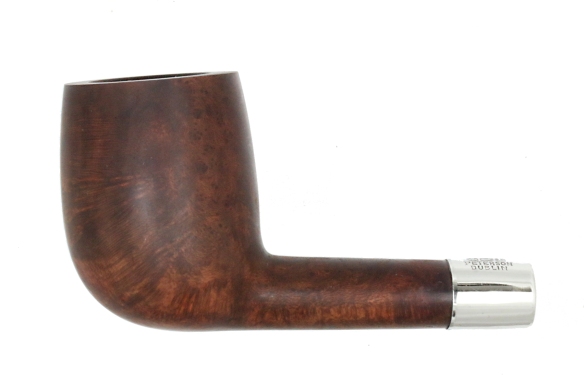 After staining, I applied Simichrome liquid silver polish to the nickel mount, let it set for a while, then rubbed it off. It’s worth noting that the nickel band is not only silver-soldered by hand, but has been turned down at both edges of the band to meet the briar and the stem. Very classy. The nickel-mark stamps are also quite well articulated and look like they’ve never suffered under the buffing wheel of an over-zealous tobacconist.
After staining, I applied Simichrome liquid silver polish to the nickel mount, let it set for a while, then rubbed it off. It’s worth noting that the nickel band is not only silver-soldered by hand, but has been turned down at both edges of the band to meet the briar and the stem. Very classy. The nickel-mark stamps are also quite well articulated and look like they’ve never suffered under the buffing wheel of an over-zealous tobacconist.
The stem is another unusual one in my experience. It doesn’t seem to have oxidized over the years, yet everything about it convinces me it is original: it was filthy on the inside, matching the massive lava and carbon; it has an extended tenon (as you’d expect); it has very light teeth chatter marks, but not on the button—further up the stem. After an extensive internal cleaning and giving the button a few passes with a soft-flame lighter to raise the light chatter, I felt I could go straight to the buffing compounds: tripoli, rouge, and white diamond, with Obsidian oil in between.
 I finished the bowl with a light white diamond buffing followed by a light coat of carnauba. Then, as insurance for James’s first smoke in an 81-year old pipe, I treated the bowl to Charles Lemon’s maple syrup / activated charcoal bowl lining.
I finished the bowl with a light white diamond buffing followed by a light coat of carnauba. Then, as insurance for James’s first smoke in an 81-year old pipe, I treated the bowl to Charles Lemon’s maple syrup / activated charcoal bowl lining.
I’m really pleased with this one—it looks like new/old stock to me—and I hope it finds its way into James’s regular rotation.
Data
Length: 5.75 in /140 mm
Weight: 0.80 oz / 32 gr
Bowl Height: 1.90 in / 48 mm
Chamber Depth: 1.51 in / 38.51 mm
Chamber Diameter: 0.80 in / 20.50 mm
Outside Diameter: 1.44 in / 36.58 mm.
Era: Irish Free State (1922-1937)
Happy Birthday, Poppa-Tom!

